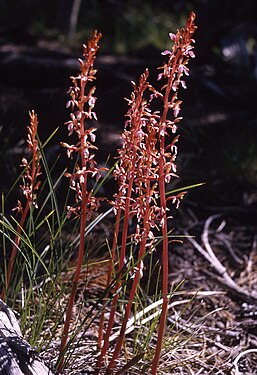Difference between revisions of "Corallorhiza"
Gardensnail (talk | contribs) |
Gardensnail (talk | contribs) |
||
| Line 1: | Line 1: | ||
__NOTOC__{{Plantbox | __NOTOC__{{Plantbox | ||
| − | | name = '' | + | | name = ''Corallorhiza'' <!--- replace LATINNAME with the actual latin name --> |
| common_names = <!--- if multiple, list all, if none, leave blank --> | | common_names = <!--- if multiple, list all, if none, leave blank --> | ||
| growth_habit = ? <!--- tree, shrub, herbaceous, vine, etc --> | | growth_habit = ? <!--- tree, shrub, herbaceous, vine, etc --> | ||
Revision as of 20:54, 9 April 2010
| Origin: | ✈ | ? |
|---|
| Exposure: | ☼ | ?"?" is not in the list (sun, part-sun, shade, unknown) of allowed values for the "Exposure" property. |
|---|---|---|
| Water: | ◍ | ?"?" is not in the list (wet, moist, moderate, dry, less when dormant) of allowed values for the "Water" property. |
Read about Corallorhiza in the Standard Cyclopedia of Horticulture
|
|---|
|
Corallorhiza (Greek for coral-root). Orchidaceae. Coral-root. Low orchids, growing in woods and parasitic on roots, destitute of green foliage, the plant usually brownish or yellowish and inconspicuous. Flowers small, somewhat 2-lipped, usually obscurely spurred at the base: sepals and petals nearly alike; lip small, slightly adherent to the base of the column; pollinia 4.—Species few, in N. Amer., Eu. and Asia. The coral-roots have little merit as garden plants, although very interesting to the student. They may be grown in rich, shady borders. Two species have been offered by dealers in native plants. C. multirlora, Nutt. (Fig. 1050). is purplish, 1½ ft. or less high, 10-30- fld., lip deeply 3-lobcd: grows in dry woods in northern states; C. Mertensiana, Bong., scape many-fld., 8-15 in. high, the lip entire and broadly oblong: occurs in Brit. Col. and north to Alaska. C. odontorhiza, Nutt., provides what is known as crawley-root, said to be used for its diaphoretic and febrifuge properties: it is a slender plant, in woods S., but extending north as far as Canada, light brown or purplish,6-7 in. tall: lip nearly or quite entire, white spotted with crimson. L. H. B.
|
Cultivation
- Do you have cultivation info on this plant? Edit this section!
Propagation
- Do you have propagation info on this plant? Edit this section!
Pests and diseases
- Do you have pest and disease info on this plant? Edit this section!
Species
Gallery
If you have a photo of this plant, please upload it! Plus, there may be other photos available for you to add.
References
- Standard Cyclopedia of Horticulture, by L. H. Bailey, MacMillan Co., 1963
External links
- w:Corallorhiza. Some of the material on this page may be from Wikipedia, under the Creative Commons license.
- Corallorhiza QR Code (Size 50, 100, 200, 500)



